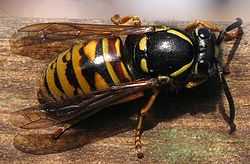Vespula rufa
| Vespula rufa | |
|---|---|
 | |
| Scientific classification | |
| Kingdom: | Animalia |
| Phylum: | Arthropoda |
| Class: | Insecta |
| Order: | Hymenoptera |
| Suborder: | Apocrita |
| Family: | Vespidae |
| Genus: | Vespula |
| Species: | V. rufa |
| Binomial name | |
| Vespula rufa (Linnaeus, 1758) | |
| Synonyms | |
| |
Vespula rufa, the red wasp or Northern red-banded yellowjacket, is a species of eusocial wasp with a holarctic distribution.
Description
Vespula rufa usually has brownish red markings on the first and second abdominal segments, coupled with the pattern of black markings, and these make identification of red wasps relatively straightforward compared to the Common Wasp V. vulgaris and the German Wasp V. germanica.[2] In some population,including those in North America, the yellow background colour is replaced with ivory.[3] Queens are 17 to 20mm in length, workers grow to lengths of 12 to 16mm and the males arenormally between 13mm and 17mm long.[4]

Distribution
Holarctic. In North America found in Canada with records from all provinces and territories except Nunavut, and the northern United States including Alaska, Vermont and New York. Palaearctic (and marginally Oriental): from western, northern and central Europe to Kamchatka, Japan, China, Taiwan, south to Turkey, Central Asia and Nepal.[3]
Biology
In early spring the queens emerge from hibernation to look for a nesting cavity. The nest is usually constructed underground in an abandoned rodent burrow or similar cavity, more rarely in cavities above ground (hollow stumps. wall cavities, bird boxes), under moss, in dense bushes, under eaves of houses or in attics.[3] The nest of the red wasp is relatively small with a diameter which rarely exceeds 20 cm. It is made from paper produced by chewing old, weathered, but dry wood. The German wasp uses similar material to construct its nest and the two species are often observed together chewing on old wooden artifacts. The nest is pale grey in colour with a smooth exterior and lacks air chambers. In the interior of the nest there are 3 to 5 combs. At its largest the nest will contain around some 700 individuals at all stages of the life cycle. However, there are only 100 to 300 workers in each nest. To rear one queen, Red wasps require only 1.1 worker, this contrasts with the common wasp which requires over 10 workers to rear a single queen. The next generation of red wasp queens and the males appear by the end of August.[4] To ensure that most of the eggs reared in the hive are from the queen, workers engage in a process known as worker policing.
By the end of September the males and workers have mostly died off and the new queens have found a place for nibernation. The Red Wasp is reluctant to sting, not even in the vicinity of the nest. The red wasp is the main host of the red cuckoo wasp V.austriaca which takes over the nest just as the workers are about to emerge and uses them to rear its own queens and males but it does not produce any workers.[4] It is also parasitised by the parasitoid flies Physocephala rufipes and Conops flavipes[5] which feed on the larvae. The nests are also subject to predation by the European Honey Buzzard.
The Red Wasp is less associated with human structures than the Common or German wasps and as a result is not as easily observed as these two species. It is, however,a very common, often even abundant species in the areas where it occurs.[4]

Red wasps prefer to capture live arthropod prey to feed their larvae and rarely scavenge. The adults feed on nectar.[3]
Habitat
It is less common in man made habitats such as parks or gardens, and prefers meadows,[5] heaths, open woodland and moorlands.[4]
Taxonomy
The northern red-banded yellowjacket was referred to as V. intermedia (du Buysson, 1905) in the North America. This differs from typical red wasps V. rufa of the western Palearctic in having ivory rather than yellow markings. Eastern Palaearctic populations also have ivory markings and this form has been called V. rufa schrenckii (Radoszkowski, 1861). Due to the variability of the brownish markings, which can be seen from specimens throughout its range V. intermedia has been synonymized with V. rufa schrenckii. However, pale-marked populations also occur within the range of the V. rufa rufa in Scandinavia and Central Asia. The ‘subspecies’ of V. rufa are now considered as little more than colour forms rather than formal taxa, and the species is regarded as monotypic.[3]
References
- ↑ http://www.discoverlife.org/mp/20q?search=Vespula+rufa
- ↑ http://www.naturespot.org.uk/species/red-wasp
- ↑ 3.0 3.1 3.2 3.3 3.4 http://www.biology.ualberta.ca/bsc/ejournal/bmc_05/95v_rufa.html,
- ↑ 4.0 4.1 4.2 4.3 4.4 http://www.gardensafari.net/en_picpages/vespula_rufa.htm
- ↑ 5.0 5.1 http://www.commanster.eu/commanster/Insects/Bees/SpBees/Vespula.rufa.html,